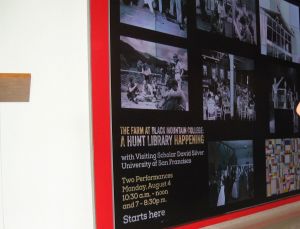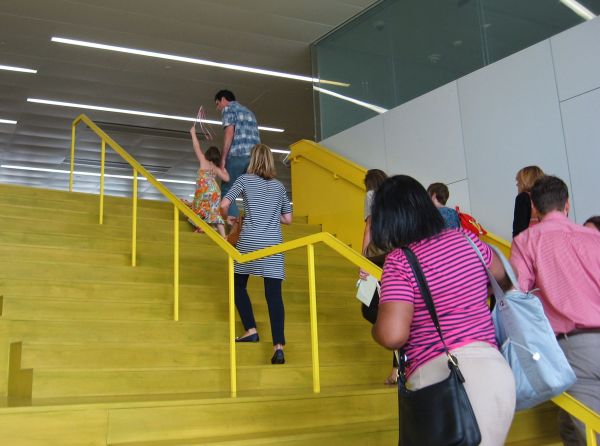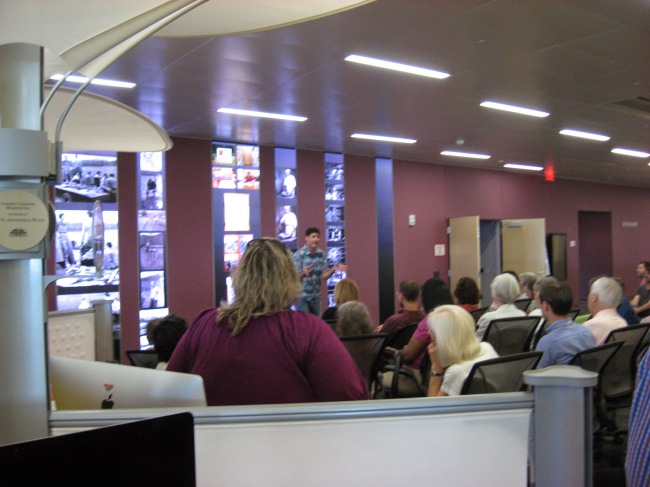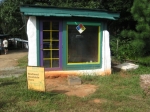Hunt Library Hosts Amazing BMC Educational Happening
David Silver, a USF professor who studies media and urban agriculture, used NCSU’s Hunt Library and its magnificent IT and media resources to provide a unique and invaluable review of the farm at Black Mountain College, and how it invigorated the sense of community, the work ethic and the physical bodies of everyone on campus. Silver, who was featured in my last BMC post, has spent countless hours poring over the images and papers in the BMC archives at the NC Western Regional Archives in Asheville. He, with the help of numerous staff members and students at the Hunt Library, created a stunning array of images in four of the library’s presentation venues. The movement, the change of scale and David’s infectious energy all made for a highly stimulating “lecture” that transcended standard academic formats.
Black Mountain College began in the Depression in 1933 and lasted until 1956. For most of those years, farm activities, conducted primarily by students, provided substantial and sometimes crucial food for the college community. The farm also helped enact the progressive ideas of the founder, John Rice, who involved students in all decision-making processes about curriculum and campus life. During the war years, the predominately female population continued and developed the farm and also construction projects on the new Lake Eden campus. In the last years before closing, the end of the farm program led to some hungry times for the nearly destitute institution. Silver showed how the farm and the preparation of its food is a research thread that reveals issues ranging from racially progressive views to education as doing, from the empowering of female students to environmental conservation.
The trek through Hunt Library started in the lobby’s iPearl Immersion Theater and then moved to the classroom above, where we turned around to each wall as it illuminated with new images. The format fit David’s active style perfectly. The sense of landscape, the huge size of the student-built barn, the humor David found in so many images, all were enhanced by the settings.
Professor Silver was generous in his praise for all the staff and students with whom we had worked at the Hunt Library. He also was effusive (as are all BMC scholars) about Heather South, archivist at the Western Regional Archives, who below watches David present.
These columns of imagery, set in the curved wall of a large work area, formed my favorite venue. A few scattered students were around, the crowd was put at ease by the vast expanses, and people could move around and come and go as they wished. I won’t try to convey much of David’s BMC specifics. He has published much and will continue to lead us all to a better awareness of how the farm influenced the education experience at Black Mountain College.
This library really is gorgeous and mind-blowing. Its namesake visited this day, but hurried right past the BMC presentation!
Book Arts, Farming Fueled Black Mountain College
The 2013 Black Mountain College conference, held at UNC-Asheville, covered much ground, as always, with reflections and insights regarding the methods, influence and legacy of the experimental college that is both revered and obscured in the history of 20th century education and art. I always come away with one or more real breakthroughs in my thoughts about these topics, and this year the BMC farm program really came to light in the presentation of David Silver. Tom Murphy spoke of the print shop and letterpress operations, and both of these sessions offered rich, practical examinations of the processes and their implications. As always, the foundation of factual knowledge and interpretation laid down by Mary Emma Harris in her 1987 book, The Arts of Black Mountain College, is acknowledged and utilized by all presenters. Ms Harris continues to lead BMC research efforts, and presented this year about BMC approaches to material studies. She showed how the low-budget humble materials used by Anni Albers and others provided a freedom and at the same time an enforced discipline on the students. “You mustn’t forbid the possibilities of the materials,” and in the notes of Ruth Asawa from Josef Alber’s class, “the whole cosmos is entertaining”. These topics were applied to Asawa, BMC sculptural artist, by Jason Andrew, who showed how Ruth Asawa’s zero-based explorations of the culture of handicraft, and her highly artistic use of negative and positive space, helped lift craft into the perceived realm of art in the mid twentieth century. Christopher Benfey, the featured speaker whose ideas I discussed in the previous post, gave a keynote speech which emphasized a similar theme: “Starting at Zero!” Get your hands involved with available material. Then make an honest response to the materials, including the industrial process involved. The conference highlighted the synergy and profound influence derived from the joining of the design philosophy of Albers and the progressive education ideals of John Rice. Experiential education and the approach of design as a “form of justice between man and material” made BMC the birthing place of many new currents in American art.
The BMC farm was a rich source of experiential education, surely, and its operations offered many practical lessons in form and design. David Silver of the University of San Francisco described how students, with Ted Dreier’s supportive oversight, had a huge influence on the development of the farm. From Harris’s book: “In the first year [1934] a vegetable garden was started by Norman Weston [BMC student and “treasurer”] and other interested community members. The college leased a 25 acre farm with a vineyard and apple orchard…” John Rice was not enthusiastic but didn’t mind as long as faculty obligations were not needed. In 1938 the farm went to the future Lake Eden, was expanded in 1941 and by 1944 “was producing most of the beef, pork, potatoes, eggs, dairy products and some vegetables used by the college” (Harris again). Last year and this, Silver offered rich detail into how the farm emblemized the integrated systems, the balance of discipline and freedom, and the “use what you find” attitude that characterized much of the college’s history. His research anecdotes, from local farmers such as Bass Allen, who taught the students how to farm, to the very Albers-like egg lists that recorded every oval, both entertain and enlighten. Mistakes, both horrible and hilarious, were made. But students gained invaluable experiences, including the closest thing BMC offered in the way of physical education. Molly Gregory, who taught woodworking and maintained the mechanical shop, took over the farm in the later years of the college and operated it at a profit. Silver’s admiring portrayal of her BMC work showed that, like Asawa, she helped create an atmosphere that bridged the gap between artisan and artist, that found a space for sublime work of the hands.
Of particular interest to me was my own arena of artisanry; the letterpress printing and other book arts that were pursued at BMC. Tom Murphy from Texas A&M Corpus Christi recounted printing efforts that were of practical help to the college but eventually played a role in the establishment of literary forces and the Black Mountain Poets as important threads in the history of BMC. Again with the support of Harris’s history, he described how Xanti Schawinsky, a noted graphic designer, helped obtain type and a press for a print shop in Lee Hall on the first Blue Ridge campus. The bulletins printed were “not flashy’ and in fact were conventional products that advertised the best face of the college to outsiders. Students like Ed Dorn and John McCandless received hands-on learning and were able to design and effect their own projects. The print shop had a long hiatus before and during the war, but in 1946 was resurrected as part of the wood shop and used in writing projects involving Jimmy Tite, Harry Weitzer, and Ann Mayer. A visit by Anais Nin in 1947 was the catalyst for new literary publications, including Poems by M.C. Richards in 1948. This set the scene for the Olson years, when BMC nurtured energies that traveled to the west coast, Paris, and North Carolina’s own Jargon Press, published by Jonathan Williams. (A fun footnote to the latter is that the BMCM+AC has acquired the imprint and publications of the Jargon Society!)
All of these insights need fuel themselves to become realized. The first session of the conference highlighted the newly emerging resources for such work. UNC-A’s Ramsey Library is digitizing and organizing web pages for several BMC collections. The Western Regional Archive continues to add collections,including the BMC Project papers, generated and collected by Mary Emma Harris. The state archive has selected BMC documents in their online archive. The Black Mountain Studies Journal offers ongoing scholarship in the field. Rich resources indeed!
Design is not decoration, design means an understandable order. It is understandibility. It is not beauty. If it is understandable, it is beautiful. Josef Albers
Book arts came up in one last surprising setting – Julie Thomson‘s highly stimulating talk on Ray Johnson’s commercial design work. She offered the quote above and astounded the audience with images of standard New Direction titles whose covers were designed by Johnson and one of his mentors, Alan Lustig. She pointed out that Ray J had done prize-winning poster work back in Detroit, was a perfectly competent graphic designer – and helped promote the idea of integrating typography with visual art and design.
Congrats to the BMCM+AC for another great conference!
Sustainable Farming in the Triangle

The 3rd Annual Eastern Triangle farm tour by the Carolina Farm Stewardship Association was a blast. There were 19 farms this year, but you can never do more than 3 or 4 a day for the two days of the tour. Cara and I spent several hours Saturday at just two farms, but they were both fascinating. Dew Dance Farm had exotic wool and fur livestock, as well as heirloom naturally colored cotton, and a live-in weaver to use it all. The Piedmont Biofuels research farm was everything I’ve been anticipating for years. Sunday I moved more quickly and did four spots, self-touring. I learned a lot about the new agricultural culture, arising from plenty of inherited Southern values (and land), as well as the most cutting edge green/sustainable practices. We are all eating differently, including more locally, and there is an interesting and decent market for these products. I was amazed to find that not only is this group sponsoring a national conference next month, there is a Politics of Food conference taking place at NCSU this very week!
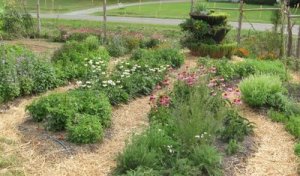
Above is a native plant area at the Piedmont Biofuels research farm. Its purpose is to provide haven and nectar for useful insects. The land is operating as an incubator farm for a couple, who are utilizing species and techniques from Japan on the site as they grow stores, develop contacts and search for land. Below a co-op intern explains the use of bamboo guides for efficient root crop production.

The clickable thumbnails above illustrate the biofuel production process, which also takes place at the farm. Lyle Estill started making biofuel as a kitchen science operation and with his partners developed this system for recycling waste vegetable oil, producing fuel and soap. Now they produce a million gallons a year at a new facility down the road – using chicken fat. This original operation continues, with the honor system pumphouse above right.

Dew Dance Farm typified the average fare of the tour – a Boomer couple using the parents’ land to operate an intensive operation with a well-funded and slight hobby-like atmosphere. As papermakers, we were entranced by the heirloom naturally-colored cotton. Growing even a dozen plants of cotton requires a special permit, inspections, and the promise to burn it all if the boll weevil shows up!
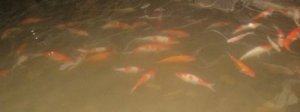
Lakeview Daylily Farm and Weston Farms on Highway 50 had a unique aspect – a koi barn and an outdoor koi pond with fencing to discourage turtles and herons. But my final destination, pictured below, was the Covenant Community Garden, operating in the heart of Fuquay Varina. Church and community volunteers use sustainable practices to grow food for a pantry, a kind of local food bank for those who need it. It doesn’t get any cooler than that. Go green!


2008 farm tour photo album
*******************
Slow Food Triangle celebrates local food and the people who grow and make it.

